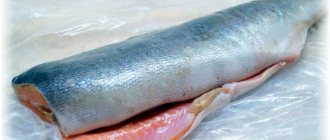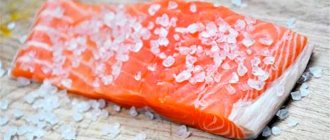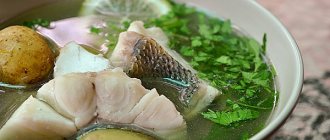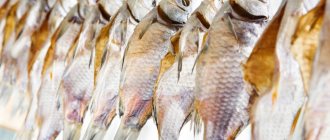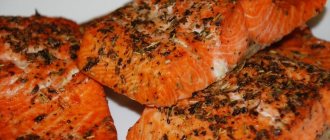Various ways to clean herring
Let's look at several methods of cleaning fish, their advantages and procedure.
Classical
The classic way to clean herring from bones consists of several stages.
- The fish is placed on a board and the head and then the tail are separated with a knife.
- Holding the herring by the fin from above, carefully trim it.
- By inserting a knife into the hole that remains, cut the belly and remove the insides of the herring. If you like milk or caviar, do not put the knife deep inside so as not to damage them. Gently spread the abdomen and free it from the insides.
- Caviar and milk can be used to make sandwiches or snacks.
- Turn the fish on its side and cut from one side, and then from the second strip half a centimeter wide. This allows the belly fins and hard parts to be removed.
- Remove the black film with a paper napkin or your hands; it imparts a bitter taste to dishes. Rinse the fish both outside and inside under tap water.
- Place the herring with its back facing you on the board and use your thumb to make a hole in the part where the fin is on top. Move up, dividing the herring into 2 halves, and then do the same, moving down.
- Place the herring on the board and use a knife to pick up the skin, grab its edge and quickly remove it. Do the same with your other half.
The herring has been cleaned! All that remains is to remove the seeds using tweezers, cut it into portions and serve.
For the "fur coat"
Here is one of the recipes for cutting fish intended for the famous “shuba” salad.
First, place the herring on the board, cut off the tail and head of the herring. Then rip open the abdomen from the caudal fin at the bottom forward and to the end. Remove the entrails from the fish.
Rinse the milk and caviar under running tap water, place in a bowl or container and place in the refrigerator. Throw the rest of the innards into the trash.
Move the knife from the ridge to the edges, clean the inside of the abdomen, scraping off the black film: first one side, and then the other. Rinse the herring under tap water. Cut off all the fins below with quick movements - caudal, dorsal and ventral.
Make a cut along the back of the fish with a knife, dividing the herring into 2 parts, not reaching the end a little. Lay the carcass on its side and use your fingers to pry the skin away from the tail. Then gently pull it forward and up with your hand. This way you will remove all the skin from both sides.
Then you should separate the fillet from the fish spine: start from the tail, carefully dividing the fish into 2 halves and, pressing your finger against the bone, move to the head and separate the meat. Do the same with the 2nd half of the herring.
All that remains is to carefully remove with your fingers the small bones remaining on the herring without disturbing the integrity of the carcass.
Rinse the fillet, cut it into cubes, and voila - you're done! You can start preparing the “fur coat”.
Punching
This culinary method will demonstrate how to quickly peel a herring without removing all the seeds.
You must first gut the carcass, cut off the fins and remove the skin. Then the herring needs to be washed and an incision made on the back. Hold it so that 4 fingers are inside and your thumb is on the cut on the back of the fish. Then you should squeeze your fingers, squeezing out the meat and separating it from the ridge.
First, separate 1 half of the fillet, and then the 2nd, and then remove the bones using tweezers.
In one motion
There is another option for cleaning fish from bones. First, the skin is removed from the carcass, the entrails and fins are removed. Holding the herring by the tail with 2 hands so that its side is facing you, tear it a little with your hands, moving your fingers away from each other, holding the herring very tightly so that it does not slip out. Holding the carcass by the tail with 2 hands, “flip” the fish towards you, the herring will describe a circle around the tail.
Then cut the herring with a sharp movement, spreading your arms to the sides. In one hand you will have the back and spine, and in the second hand you will have two strips of the abdomen. All that remains is to carefully separate the back from the bones using tweezers or fingers. Place the fillets on a plate and cut into portions and use in the preparation of the dish.
Salted, smoked and dried fish
Of course, cleaning fish from scales is not the easiest process, but sometimes it’s no less a hassle with salted fish. For example, preparing salted herring fillets for a salad can also cause difficulties:
- Having taken the fish out of the brine, you need to cut off its fins with kitchen scissors.
- An incision is made along the back with a short knife. We must make sure that it is not too deep.
- The same shallow incision is made around the head on both sides.
- You need to separate the thin skin from the incision and begin to remove it with a “stocking”, moving towards the tail.
- Having received a fish without skin, you need to take kitchen scissors again and rip open the belly with them.
- Caviar or milk is pulled out of the abdomen (lightly salted caviar, by the way, is very tasty and healthy).
- Use your hands to pull out the intestines and bladder.
- Use a knife to remove the black film.
Now you can simply cut this herring into portioned pieces, or you can fillet it, freeing it from the backbone, and cut it into small pieces for salad.
Dried fish, especially roach, is a favorite snack to accompany the foamy drink. But even those who love it very much do not always know how to clean it quickly and easily:
- Taking the roach by the tail with one hand, with the other you need to, with short movements towards yourself, tear off the belly along with the ribs.
- There should be a “pocket” in which caviar may appear. If it is not there, then the belly is simply put aside and not eaten.
- Grab the fish by the tail again and tear off the fin.
- In the place where the fin was, the peel comes away from the pulp well. You need to grab the edge of the skin and remove it from the fish.
- Now all that remains is to separate the fillet from the spine.
Of course, there will be significantly fewer edible parts than skins and bones, but they are very tasty. Therefore, many do not deny themselves the pleasure of eating dried roach.
To clean a small cold-smoked fish, first remove the skin, which comes off easily if you start to remove it from the back. Then you can tear off the head and fins with your hands. Unfortunately, the fins of smoked fish are quite prickly, so some people use scissors in this case.
You need to take the carcass in your hand and tear off the belly along with the entrails with the other hand. When only the back remains, it must be separated from the spine and you can eat it.
If fish cutlets or simply steaks, steamed or baked in the oven, are a very healthy dish (especially in tandem with vegetables or brown rice), then salted, smoked and dried fish are contraindicated for those with kidney or liver problems. This is because salt retains water in the body, and smoked foods have a bad effect on liver function.
How do you usually clean fish? Tell us about it on .
https://youtube.com/watch?v=mTT8Vw3eX-E
Step-by-step instructions for filleting frozen mackerel
It is recommended to defrost a freshly frozen carcass before cutting, but not completely. Since frozen mackerel is easier to peel and remove the giblets. Below are the main points for cleaning a carcass before cooking.
Removing the head and fins, entrails
Before cutting, the mackerel should be washed in running cold water to remove any dirt that may have stuck to the fish during transportation. It is not advisable to rinse the carcass for a long time, since the fillet can absorb unnecessary moisture.
Further actions are in the following order:
- The washed carcass should be dried well with a towel. Otherwise, the fish will slip in your hands when cutting.
- Next, you need to place the carcass on a board and rip open the peritoneum with a sharp knife. To do this, you need to carefully and not deeply insert the knife near the head, and smoothly move it towards the tail of the carcass. Important. Mackerel should be cut open carefully so as not to damage the integrity of the insides.
- Carefully remove the giblets and inner dark membrane. It is extremely important to remove all the dark film, as it is bitter. If the film is difficult to remove, it can be scraped off with a knife. When removing internal organs, it is important not to damage the gallbladder, otherwise the fillet will become bitter. It is impossible to remove the bitterness with any marinade. This carcass will need to be thrown away.
- Place the carcass under running water with the opened peritoneum facing up and rinse the abdominal cavity thoroughly to remove any remaining mucus and blood.
- You should also wash and dry the cutting board and knife.
- Wipe the carcass again with a towel, including inside the peritoneum.
- Place the mackerel on a board and, using a sharp knife, make cuts on both sides of the ridge along the entire length, departing from the ridge by approximately 3 mm. The cuts should be made at an angle of approximately 35-40 degrees. Remove the cut part of the carcass along with the dorsal fins.
- Then, using scissors, you need to cut off the tail and side fins.
- Next you need to cut off the head. It should be cut off in the gill area, just above the head fins. If the head is needed in the recipe, then the eyes and gills must be removed from the head.
- Finally, you need to cut off approximately 0.5-0.7 cm of fillet in the area of the abdominal incision on each side. This part contains fat, which has a pronounced fishy aroma, as well as a not very pleasant taste.
After completing the manipulations, the carcass should be rinsed again and dried with a towel.
Skin removal
If a carcass without skin is required for preparing a dish, then after cutting off the head, fins and removing the giblets, the following manipulations should be carried out:
- The prepared carcass should be placed on a dry, clean board.
- Then, using a sharp knife, you need to make an incision in the ridge area.
- Next, you need to use a knife blade or your nails to pry the skin near the head and gently pull it towards the tail of the carcass. Actions should be carried out smoothly so that the skin does not tear.
- Turn the mackerel over and repeat the procedure to remove the skin from the second side of the carcass.
After removing the skin, the fish must be rinsed again and dried with a towel.
Filleting, bone removal
If the recipe requires using only fillets, then you must first complete the first 2 steps (remove the head, fins and remove the skin).
Subsequent actions are carried out in the order described below:
- To remove the bones, the prepared carcass must be completely defrosted. Otherwise, it will be difficult to remove the bones from the fillet.
- Thawed prepared fish should be washed again and dried with a towel.
- Next, you need to feel the ridge with your thumb (near the head of the carcass).
- Then you should carefully move your finger along the ridge, lifting the fillet.
- Continue manipulation until one half of the fillet is detached from the backbone.
- Then you need to similarly disconnect the second part of the fillet from the ridge. If the manipulations are performed correctly, then all the bones will remain on the ridge.
After completing the manipulations, it is advisable to check the fillet for the presence of remaining bones. If bones are found, it is recommended to remove them using special tweezers.
If you still use a frozen carcass, then the manipulations will be as follows:
- Place the mackerel on the board and insert the blade of a knife from the side of the head between the meat and the ridge.
- Smoothly move the knife along the ridge towards the tail, lifting the pulp.
- Similarly, cut off the second part of the fillet from the backbone.
- Next, you need to remove the remaining bones from the meat using tweezers.
This method is not very popular, as bones remain in the fillet.
Standard cleaning
Everyone faces the common problem of cleaning fish by using the wrong methods. You need to know that this procedure has been carried out since ancient times to this day. Many methods have been invented, and all chefs agree that the classic method of cleaning is relevant and effective.
Classic technology
As a general rule, it is best to clean fish fresh when it has been recently caught or purchased from a store. Only after processing the carcass is placed in the freezer for further storage. It’s better to do the work directly on a pond or in the yard. In this case, you can avoid contaminating the kitchen with scales. How to properly clean fish using the classic method:
- To simplify the task, it is advisable to treat the product with salt - this will prevent it from slipping.
- First, all the fins are removed, but the tail remains in place. The tail is needed to hold the fish, and the fins are cut off in order to avoid injury: there are different specimens and some of them have sharp fins.
- After the fins, start cleaning. Take a long, sharp knife. A large knife makes it easier to remove scales. Next, the fish is placed on a cutting board and held by the tail. Then place the knife on the tail and move it in the direction of the head: you should always clean the fish against the direction of the scales.
- To prevent scales from flying all over the room while working, place a large container of water on the table and place the product there. The same manipulations are performed as in the third point, only under water - this will prevent the scales from scattering.
- After removing all the scales, you should begin gutting. At this step you will have to arm yourself with a narrow knife, but very sharp. Turn the fish onto its back and insert the knife at the base of the head, moving the tool all the way to the lower fin, thereby ripping open the belly. Next, all organs are removed - this can be done either with a knife or with your hand. It's easier to use your hand and pull out everything that's there. Carefully remove the gallbladder.
- After removing the entrails, perform a visual inspection for the presence of caviar. Housewives often find caviar inside fish, which is also healthy and tasty.
- If the selected recipe involves cooking the entire product in the oven, then only the gills are removed.
After the work is done, the fish is washed again under running water.
Cutting in other ways
If you plan to fry the fish in pieces, it must be cut into even pieces.
The carcass is placed on a cutting board and the tail and head are removed. Then use a knife to make cuts on the side so that they are the same size, and then cut the product into pieces. First, in the cutting process, you will go through the flesh and encounter a strong backbone. To overcome an obstacle, place one hand on the edge of the knife and keep the other on the handle. Then sharply and forcefully press on the handle of the tool and break the fish’s backbone, after which the remaining flesh is cut off. To remove the fillets, do not gut the fish into pieces, as some housewives do. The product is placed on the workplace - a cutting board. Take the carcass by the tail and cut it in half lengthwise so that the knife blade passes close to the spine. You will get two parts, on one there will be ribs, and on the second - the ribs and ridge. Now remove the bones by scooping them out with a knife. The job is done, cut the finished fillet parts into equal parts.
